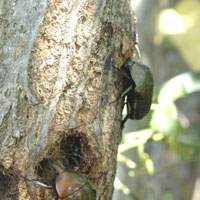* Scientific name: Rhomborrhina japonica
* Description: Large, handsome and sturdy insects, drone beetles have distinctive antennae that end in a club that can be fanned out to form a leafy antenna with a large surface area -- the better to detect odors carried in the air. The beetles are around 4 cm long, with large eyes and a metallic sheen on the exoskeleton ranging from copper to green. There is a triangular section on the abdomen where the wing cases meet, and the head is large, armored and rectangular in shape. The legs are broad and very strong, with hooks on the end enabling them to grip hard to tree trunks.
* Where to find them: In deciduous forests and parks in Honshu, Shikoku and Kyushu.
* Food: Drone beetles are fond of liquid diets. They fly to trees that are leaking sap, and feed on the fluid. When flying, the heavy insects hang awkwardly in the air, legs held outward ready to land, and the wing cases held clear of the large hind wings. They make a droning buzz when airborne. Drone beetles also eat flower nectar and the juices made by soft ripe fruit. To find the best source of food, the beetles spread out their leafy antennae to detect the telltale smells of fruit and sap. The large, fat larvae of drone beetles live in soil and rotting logs, and feed on decomposing leaves.
* Special features: Drone beetles are a type of scarab beetle, which were revered by the ancient Egyptians. The sacred Egyptian scarabs were dung beetles, and it has even been suggested that their habit of making a "brood ball" of dung in which their larvae live inspired the Egyptians to create the mummifying process. Drone beetles are not as common as they used to be. One of the Chinese characters for kanabun is a form of the character for "mosquito." They don't bite, but perhaps in the past they were as common, and as noisy when flying, as mosquitoes.
PHOTO COURTESY OF BIO-IMAGE NET


















With your current subscription plan you can comment on stories. However, before writing your first comment, please create a display name in the Profile section of your subscriber account page.